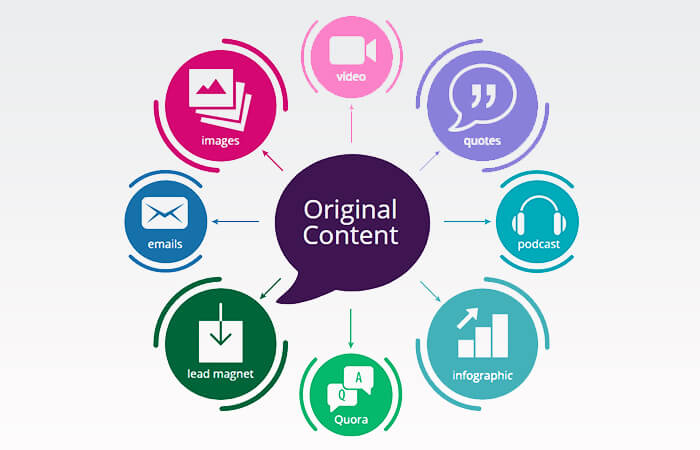As a small business owner, you have to compete with big businesses. These businesses have enough capital to market their goods. And they market it through conversion and promotional ads. The best marketing suggestion you can get is content marketing tips for SMB owners.
In the social media world, different content is fighting for your prospect’s attention. And with human’s short attention span, only valuable content can boost your social media marketing game. That’s what makes this article so perfect for you.
So join us as we cover content marketing tips for your small business that generate results.
What is Content Marketing?
There’s a lot of fuss over how content marketing is suitable for your business and how Content is King. So what is content marketing, and how is it applicable to business owners?
Content marketing is a marketing strategy that involves creating valuable digital content. Then, content marketers distribute the content on different platforms to gain the visibility and trust of your potential customers.
Content marketing efforts are not primarily aimed at selling right away. Instead, it grooms the audience and provides them with related and relevant information. Making them willing to buy when the time is right.
More social media platforms are creating business platforms. So the need for content marketing grew alongside. However, during the Covid-19 pandemic, online stores became more prominent. And there was an urgent need for content marketing to filter the noise from many online stores.
10 Most Effective Types of Content Marketing for Small Businesses
There are many ways of creating digital content. It can be text, pictures, or videos; each has its specific audience size and market. Also, there are various ways to distribute it.
Below is the list of the best content marketing types. Choosing what suits your audience depends on what fits their taste and needs.
1. Blog Posts

A blog post is a form of content writing. It can be an instruction, article, news, or other information published on a website. It’s usually about a specific topic. It can contain links to valuable posts, images, interactive charts, infographics, and videos related to the topic to create authority.
To drive traffic to your blog post, share links with your audience to access the information on the page.
And if you want to drive traffic to your blogs automatically, they must be optimized for search engines. Search Engine Optimization makes your article rank high so that anyone looking for similar information will find it on the first page of Google.
If you don’t know what to write about, research your audience’s problems (related to your product) on well-known keyword research tools. Then report on how to solve the problem.
2. Email Marketing

In 2020, email marketing was the most effective marketing channel. Yes, you heard it right. Despite competing against competitive digital marketing alternatives, email marketing has still got the game. It yielded the highest Return on Investment (ROI) for e-commerce retailers.
The average adult treats their email as another social media platform. But email contains relevant information to their daily life and career.
Because people’s emails are private and primarily filtered, it’s easy to market to your audience via the platform without anyone else.
The email can inform them about new products, additional services, and discounts. And it can also be valuable content on how to use products, care for products, or other related Content.
You do not have to send an email every day so as not to overwhelm your audience. However, no matter the frequency, ensure it is consistent
3. Visual Content Marketing

As the name implies, visual content marketing involves creating visual content. It includes videos, images, animation, and GIFs to disseminate information to your audience on different channels.
In the competitive business world, It goes beyond stunning images. The visual content must also convey a message that must be easily understandable.
Visual content is preferred above many other forms of content marketing. Almost 70% of companies invest in content marketing, including visual content creation strategies.
This is because the human mind retains visual information better than other forms. Therefore, a good part of visual information is adding it to these different forms of content marketing.
4. Lead Magnets

A lead magnet involves giving valuable information or service for free. This is to get direct access to your target audience (via their mail or other contact details).
The free resources you give your audience as a lead magnet must be valuable and catchy. It will convince them that you are an expert in your niche and market your services to them.
A few examples of lead magnets include:
- A free trial for a software or service
- Valuable ebooks
- Newsletters
- Free consultations, etc.
Even though you are not selling anything with the lead magnet, you will get access to your target audience. Then via their contact details, you can sell to them later.
5. Social Media

Social media are the platforms where you can market your content and goods. And each medium has a suitable content form to sell with. So, for example, visual content works best on Instagram and Pinterest, text posts on LinkedIn and Twitter, long-form content on Facebook, and the list goes on.
It might not be easy to be present on all these platforms as a small business. Instead, you can choose one on which you will be active and market consistently on that platform.
Another great practice is to repurpose your existing content and publish social media posts. By doing this, you can present your content with a completely different narrative to new audience segments.
6. Ebooks

Ebooks are like blogs, but they contain more information and provide more detailed information on a topic. They can be in different formats, including PDF, DOCS, EPUB, etc.
They can be used as lead magnets to attract prospective customers. Moreover, you can use them to act as a guide on product usage for your customers.
7. Slide Decks

A slide deck is also called a pitch deck presentation. It collects information in slides with a topic directed toward a specific audience. A slide deck is suitable for presenting ideas to a group of people.
Business owners mainly use it to present
- Business proposals and plans
- Target market analysis
- Financial goals, etc.
You can create content for informative slides and share it on Slideshare, one of the biggest online slide-sharing platforms.
8. Video Content Marketing

Video marketing is a form of visual content. It involves creating, editing, and sharing video content to pass across information to your customers. Video content is more explanatory and engaging than picture content.
Therefore, video content is most popular among content marketers.
But before making video content, you have to ensure it will invoke the interest of your audience because of their short attention span. Depending on your message, you have to be wary not to bore them.
You can develop various video content types using several free tools—these range from live videos to explainer videos, webinars, product videos, etc.
9. Whitepapers

A white paper is an informational document. For example, businesses use white papers to highlight or promote features of their product and their offers.
Compared to slide decks or other marketing materials, white papers are plain and just focus on the information they offer. They also make use of B2B marketing.
10. Infographics

An infographic is a collection of data visualization to overview a topic or analysis. Some of the data visualization tools used include bar graphs and pie charts.
There will also be detailed images of statistics and little texts.
An infographic can present statistical data, informational Content, and the process of a marketing strategy or content marketing campaign.
You may also find this interesting The All-in-One Content Marketing Checklist for Small Businesses
Important Content Marketing Tips for Small Businesses
Knowing the types of content marketing is not enough. You need content marketing tips for small businesses. This will help you with the proper content creation process.
Know Your Audience

The first step to creating and publishing content is knowing your audience. Knowing your audience is crucial to creating future content marketing strategies.
Content must be helpful and valuable to your audience. So, you have to research their search intent to understand what content to put out and how to put it out.
Some of the ways to know your customers better are:
- Ask Your Potential Customers’ Questions
What better way to know someone other than directly from the horse’s mouth. Therefore, one of the key content marketing tips is to ask your customers questions. This will help you craft content they want to consume and engage with.
- Look at Your Competitors
If your competitor is making sales, they must be doing something right. So, check out their brands, marketing strategies, and similar things.
- Create a Buyer Persona
A buyer’s persona is a list of information about the audience, including basic ones. It’s to know your audience well and filter your target audience from everyone. A buyer’s persona will help you when you want to run ads for particular demography.
- Check Spaces Where They Are
Sometimes, your clients might not tell you all the facts about their problems and wants. But they will gladly say it when they feel they are talking freely. So check out their social media handles, and look out for their comments and engagements. Then you will get to know more about them.
- Conduct Surveys
The survey can be questionnaires or digital formats. Ask what you want to know about them.
- Their pains
- Preferred solutions
- The delivery difficulty, and any other suitable questions.
Find Topics With Traffic Potential
Once you know your audience well, you’ll understand the suitable topics that will drive organic traffic. Keep asking questions and sending out survey forms so that you do not run out of content ideas.
Take note of all of the questions they ask and their suggestions; you will be able to form content out of those. Also, if you notice a prominent buying object, you can deal with it in your content.
Content is not just about answering their questions but tackling their objections and showing them reasons to like and trust you.
Create a Monthly Content Calendar

Creating content is not easy, and neither is putting it out. And to achieve a successful content marketing strategy, you have to stay consistent. To remain consistent over time, you should plan how often you want to publish content.
Then for all the days, you want to put out content, you should have prepared the range at least a few days before. So all you have to do when it is time is upload the content on the appropriate platforms.
Achieving all these will be better with a monthly content calendar. The content calendar is an overview of your posts, the day you want to post, captions you will post alongside, and other necessary information.
Analyze Your Competitors’ Content

It’s not right to obsess over your competition’s content and strategies. But you still need to analyze them to create a solid and unique selling point.
To analyze your competition’s content, look for their top-performing posts in Google analytics. Read the post thoroughly, and check for loopholes and weak spots. Then use the weakness to create better content.
It doesn’t stop at their content. Check their content marketing strategy, and ask these questions.
- What skills are they integrating into managing their social media accounts?
- Are they collaborating with other brands?
- What do prospects compliment most about their services?
- Do customers complain about their services?
Knowing their strengths and weaknesses will help you understand what to incorporate into your business, focus on, and things to avoid. This gives you the upper hand.
Find Gaps in the Market
Creating a new product or service or being the first to introduce a new trend or innovation pushes you out there. And it gives you a chance at being a long-lasting business.
Some of the ways to find gaps in the market are by
- Monitoring Trends
There is always a problem to solve, and there is always something new the market wants. If you listen closely enough, you will get to know it. Keep up with your audience’s engagements and comments.
- Get Feedback
You should not assume that your customers are satisfied with your goods because they gave no feedback. Many will keep quiet and buy from another competition. So, ask them directly what they think about your product, what they would like to be a part of the services, etc.
- Improve an existing product:
Your audience might not want a new creation; they might just want an upgraded version of the old. Try out different techniques until you get the right upgrade.
- Incorporate international ideas: Sometimes, all you have to do is bring in a vision from overseas. Then incorporate it into your business. Check out global companies doing the same as you, and see if you can use any of their product or service ideas.
Play to Your Strengths

Another content marketing tip is to play to your strengths. You can determine your strengths with your experience, skills, knowledge, and competence.
To create your unique selling point with your strengths, do the following:
- Write down all your strengths related to your product and services.
- Explain them all in detail.
- Make a list of what you can achieve with the strengths
- Create a connection between your strengths with your customer’s deepest pains. Look for ways your strength can solve problems relating to your product’s benefits.
- Choose a unique selling point using these points and the competitor’s analysis.
Keep Your Content Consistent and Fresh
You don’t stop at making an impression in people’s minds; you have to keep that space in their minds. Always be in their faces with your content, and be an authority figure, such that when they need a product or service you render, you will be their first go-to.
Then make sure your content is up-to-date. Keep giving them the latest while recycling the helpful old Content.
Repurpose Your Content for Better Reach

It’s easy to run out of what to talk about, especially if you consistently show up. The excellent party is humans are forgetful, so they still need reminders of some content you have written beforehand.
Instead of starting all over, check some of your old posts, and pick out important points or tips. Then repurpose them so that it is still valuable and fits into the trends.
Be Opinionated
Don’t be afraid to take your stand as an authority figure. Choose what you stand for, and hammer on it repeatedly with no fear. Let people know how much you believe in your product and its benefits.
Use Analytics to Track the Performance of Your Content
You’ll need to know how well your content is performing to know what to scrap, what to do better, and what to keep doing. Some of the things to look out for to track your content performance are
- Traffic
Whether on a website or a social media page, you can check the number of views you have had and how often it was checked out.
- Engagement
Even if you can drive traffic to your page or site, your Content will make prospects remain there. Check out how well people engage your posts and the number of likes, post saves, and comments.
- SEO Performance
If your post can come up on the search engine’s first page, you are doing something right. Search engine leads are one of the best customers you can get
- Sales
As a business owner, the primary purpose of your business is to make profits. Of what use are the likes, engagement, and traffic if they do not convert to sales. After getting leads from your websites and social media pages, it should be easier to close the clients to buy the products.
There are different tools available for content performance analysis. Instagram and Facebook have a setting that allows you to know:
- Your page views
- The number of people who have viewed the post
- How many people liked, saved, and shared the post.
There are also external tools that help you check your analytics. Choose a suitable one for whichever platform you use to promote your Content.
Final Thoughts
No matter what you are selling, you have a space in the online world. And this space will need valuable content to be able to capture and hold your customer’s attention. Your competitors are likely into content marketing already, so you have to stand out.
Content that stands out will consider the user’s spoken problems and solutions. And it will also consider issues the customers didn’t know they had.
Start your content creation and marketing today. Book your Discovery Call now!


